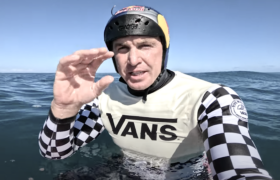"This new series is a chance to turn things round. But this can only happen if the filmmakers have been given enough freedom."
Would you believe me, friends, if I told you that Kelly Slater’s wildest, most unlikely dream might come true?
A grapple with Joe Rogan followed by a buffet of veterinary medicine and cutting edge performance enhancers?
A 12th world title?
Commissioning me to write his biography? (Working title: “Peaks and Trolls: How Kelly Slater Surfed Decades of Waves on Water and Online”)
None of the above.
Kelly’s dream, as we surely know, is worldwide recognition and fame. Being mobbed in supermarkets, appearing on mainstream chatshows, hobnobbing with the world of true celebrity.
He’s not content to watch from the sidelines, he wants to be slapped in the face.
And maybe, just maybe, this is about to become reality.
Apple TV have just announced that their (terribly titled) docuseries following the WCT, “Make or Break”, will drop on April 29th with a full seven episodes for your delectation and pleasure.
Not only that, but they’ve already commissioned the second season which is currently following the 2022 tour.
(Pardon me a moment whilst I channel Charlie Smith…)
But let us go to the press release:
“Make or Break” offers an intimate deep dive into the aspirations, challenges, accomplishments, and personal lives of the surfers who compete to remain on the elite 2021 Men’s and Women’s WSL Championship Tour (CT), and takes viewers on a journey to stunning surfing locations across the globe. The series follows the 2021 competition, navigating as the league responds to the global pandemic, while exploring the dynamic surfing culture along with timely issues, including diversity, mental health, and the physical impact of the sport.
Each episode in the seven-part first season of the series spotlights internationally recognized surfers and features never-before-seen interviews with:
11-Time World Champion and 56-Time Career Victory Winner Kelly Slater
Seven-Time World Champion Stephanie Gilmore
Three-Time World Champion Gabriel Medina
Two-Time World Champion Tyler Wright
2019 World Champion and Olympic Gold Medalist Italo Ferreira
2021 Olympian Tatiana Weston-Webb
Additional notable surfers featured in “Make or Break” include Morgan Cibilic, Johanne Defay, Leonardo Fioravanti, Jeremy Flores, John John Florence, Filipe Toledo, Kanoa Igarashi, Matt McGillivray, Isabella Nichols, and Jack Robinson.
Big deal, you say?
Well IMO it is a pretty fucking big deal, as it happens.
If you’ve watched the Netflix series “Drive to Survive” about Formula One you might understand a little of why.
“Make or Break” is produced by the same people, a UK based film production company called “Box to Box Films” helmed by James Gay-Rees and Paul Martin.
I was a latecomer to “Drive to Survive”. People kept recommending it and I kept brushing it off.
Formula 1, the most boring, unrelatable “sport” on earth?
Why on earth would I watch that?
But then I did, and from a cold and standing start I was immediately captivated.
And I do mean cold. I hadn’t watched F1 since I was a kid, and only then because my old man’s a fan. It would be accurate to say that not only did I have zero interest in it, I actively disliked it. Couldn’t see the entertainment or value at all.
Consider now, then, after I’ve binged all four seasons of “Drive to Survive” on Netflix and I find myself checking in on qualifying times for the Saudi Arabian Grand Prix.
Being utterly hooked on the docuseries has transitioned into an interest in the sport itself.
I’m not alone.
“Drive to Survive” has lit a flare in the global popularity of F1 racing. Interest and audiences exploded along with revenue.
It doesn’t matter if you have any prior knowledge or interest, within a couple of episodes you’ll be drawn in. Try it and see.
What the series does so expertly is craft narrative and create human interest in a world for which we have no context. The races are part of it, but they’re secondary to the people. And it’s not just the drivers, but agents and managers and wives and bosses and coaches and journalists*, and all the people that contribute to the billion dollar circus that is F1 racing.
Beyond the sums of money involved, Formula One and professional surfing aren’t so different.
Both involve a small and select group of elite performers and their entourages travelling the globe to compete in something that most people can’t possibly understand. Both involve long periods of monotony punctuated by random periods of intense action.
To be successful, the primary goal of both must be captivating audiences who can’t understand anything about the environment or performing at that level.
The key to this is skilful storytelling. You find characters we can root for and identify broad themes we can recognise – vulnerability, pressure, uncertainty, balancing lifestyles, trauma, relationships…
The “Drive to Survive” series found these characters and excavated the themes. In doing so it compelled us to watch a sport that most people thought was dead, dull or alien.
If Box to Box Films have been allowed to take the same formula to the “Make or Break” series, professional surfing might finally be catapulted into mainstream consciousness that has been desired and promised since the Tour began.
For this to happen, the filmmakers must have been given free reign and access to anyone they like, and I would hope they’ve been met with candidness from their subjects. I’d like to hear from everyone involved, the surfers, coaches, sponsors, caddies, significant others, journalists*, even judges… (Imagine that!)
I hope there’s no greenwashing.
The lack of this in “Drive to Survive” was refreshing. They didn’t acknowledge the thousands of kilos of rubber and fuel that was incinerated by each team every couple of hours (as if it weren’t obvious) but at least they didn’t try to dress it up or pay lip service to green initiatives. There was no pretence.
I very much hope the WSL can buck their own trend and do the same. You can’t compare the impact of pro surfing to F1, of course, but they’re still flying around the globe en-masse, often to places with fragile eco-systems, and they’re still churning through foam and fibreglass.
Let’s not pretend we’re saving the world. It’s entertainment, and we’re all trying to make money from it.
The WSL’s objectivity problem is well established. The Wall of Positive Noise is tall and unscalable, and this has created situations both comical and farcical. Trust from the core fanbase has been eroded and the casual fan finds it unwatchable. They are undoubtedly the most Orwellian sporting organisation in the world.
My faith in the WSL, like yours, is damaged, but I do want them to succeed. This new series is a chance to turn things round. There’s a new audience waiting to be found, and an old one waiting to be fulfilled, but this can only happen if the filmmakers have been given enough freedom.
Box to Box Films understand that where there are people under pressure there’s drama. You don’t need to manufacture it, you just need to ask the right questions and be there in the right moments. The WSL have never grasped this.
It’s a little worrying to me that every press release that has accompanied news of this series has included “in partnership with the WSL” and listed Erik Logan as an executive producer.
Professional surfing has long needed an outside perspective to drive mainstream interest, but Logan has proven by now that his perspective is flawed. But as much as we’ve critiqued his understanding of surf culture, we have at least acknowledged his political and media savvy.
There’s no doubt that Erik Logan wants to be the saviour of professional surfing. We can only hope that in this instance he has understood that sometimes in order to save something you have to let it go.
*As the premier reporter of professional surfing working in 2022, and surely the most personable, handsome and objective, I’ll be deeply disappointed if I’m not offered a similar role to F1 journalist Will Buxton in “Make or Break” at some point.






